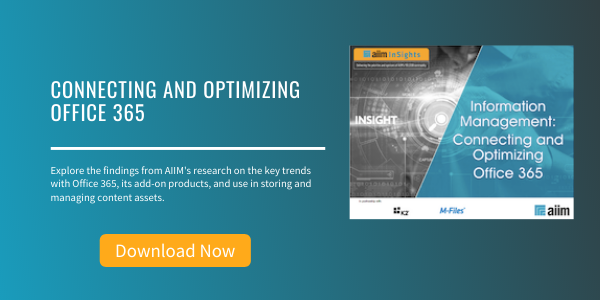
8 Things You Should Know about Transactional Processing in SharePoint
Sharepoint and Office 365 | Capture and Imaging
SharePoint is making inroads as an ECM or Records Management system, primarily because of its document library features, price, and integration with Office. But, for SharePoint to move beyond that and become the system to do document-centric transactional processing, you’ll need to customize and plan your SharePoint installation more carefully.
-
Design your Document Taxonomy.
Before you even start using SharePoint for your document-centric workflows, create content types for each type of document, taking care to define the metadata that must also be captured with this document. Think about the full lifecycle of the document and what data will be needed at each step.
-
Scan your paper documents into SharePoint.
Many transactions start as paper, so scan and capture them into SharePoint as soon as possible. Advanced image processing techniques, such as forms recognition and OMR, can detect the content type and kick off the correct workflow automatically.
-
Extract information with OCR, barcodes, and manually.
Documents that start as paper need to have their meta-data extracted from the document image that results from the scan. This can be done automatically with OCR and barcodes or manually. Even if it’s done manually, OCR can assist the data entry.
-
Automate your workflows as much as possible.
Building workflows can get complicated very quickly, so start with simple processes first. As your workflows become more complex, the key is to minimize the need for manual intervention as much as possible.
-
Use document viewers that are SharePoint-aware.
When you do need to view documents in a workflow, use a document viewer that is SharePoint-aware. When you open a file with Office in SharePoint, it knows that the document came from SharePoint and can save modifications and follow your checkout procedure. But what about other types? There are third-party viewers that are SharePoint-aware, or even better, are integrated right into SharePoint’s web interface.
-
View documents in context.
When working on a document, use viewers that can show you more than just the document. To efficiently work on a document, you need to see its meta-data, its location in SharePoint, and any outstanding workflows.
-
Use side by side comparison.
Many transactional workflows need to view two documents at the same time. For example, in accounts payable, you need to see the invoice and the purchase order simultaneously in order to pay the bill. Use document viewers that can support side-by-side viewing with some kind of page synchronization.
-
Plan for Archiving and Retention.
The full lifecycle of a document includes its transition into a record. Design your content-types so that different policies are represented in the documents meta-data and use workflows to trigger the transition automatically.
About John Mancini
John Mancini is the President of Content Results, LLC and the Past President of AIIM. He is a well-known author, speaker, and advisor on information management, digital transformation and intelligent automation. John is a frequent keynote speaker and author of more than 30 eBooks on a variety of topics. He can be found on Twitter, LinkedIn and Facebook as jmancini77. Recent keynote topics include: The Stairway to Digital Transformation Navigating Disruptive Waters — 4 Things You Need to Know to Build Your Digital Transformation Strategy Getting Ahead of the Digital Transformation Curve Viewing Information Management Through a New Lens Digital Disruption: 6 Strategies to Avoid Being “Blockbustered” Specialties: Keynote speaker and writer on AI, RPA, intelligent Information Management, Intelligent Automation and Digital Transformation. Consensus-building with Boards to create strategic focus, action, and accountability. Extensive public speaking and public relations work Conversant and experienced in major technology issues and trends. Expert on inbound and content marketing, particularly in an association environment and on the Hubspot platform. John is a Phi Beta Kappa graduate of the College of William and Mary, and holds an M.A. in Public Policy from the Woodrow Wilson School at Princeton University.



